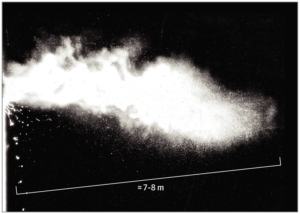ROBOTS USED TO DISINFECT ROOMS
Under the above title, Switzerland Global Enterprise, the official Swiss organization for export and investment promotion with offices in 31 countries, has featured the aseptobot in the NEWS section.
Under the above title, Switzerland Global Enterprise, the official Swiss organization for export and investment promotion with offices in 31 countries, has featured the aseptobot in the NEWS section.
There is extensive literature on the transmission routes of SARS-CoV-2. Essentially, two transmission routes are distinguished: airborne and contact transmission via contaminated surfaces.
Transmission occurs through larger droplets and small aerosols, which are transferred from one person through breathing, coughing, talking, singing and sneezing to another person who inhales the droplets or aerosols.
Droplets fall to the ground relatively quickly, while aerosols “stay” in the air for a relatively long time. What does “relatively” mean?
The air we breathe consists of droplets between 0.2-20 µm. [1] It can be shown that for a person 175 cm tall, it takes about 20 seconds for the large droplets of breath to fall to the ground. The small aerosols reach the ground only after a very, very long time (days). These are theoretical considerations which do not take into account environmental influences such as temperature (evaporation), speed of the ambient air and pollution of the air.
When sneezing and coughing, the horizontal velocities of the aerosols are much higher than the sinking velocity, i.e. during the descent these aerosols are also carried very far. The video at the following link shows impressive pictures of how aerosols can be carried up to 8m. These droplets settle on surfaces and can lead to contact transmission.

The authorities in Switzerland, Germany and Austria therefore do not rule out contact transmission:
FOPH, Switzerland: When infected persons cough and sneeze, infectious droplets get onto their hands or onto neighbouring surfaces. Another person could become infected if they pick up these droplets with their hands and then touch their mouth, nose or eyes. [2]
RKI (Robert Koch Institute), Germany: Transmission through contaminated surfaces cannot be ruled out, especially in the immediate vicinity of the infectious person [3].
Federal Institute for Risk Assessment: Furthermore, transmission via contact or smear infections cannot be ruled out. In this case, pathogens that are on the hands reach the mucous membranes of the nose or the eye, where they can lead to an infection [4].
Austrian Health Office: the novel Corona virus can also adhere to the skin and on objects (e.g. door handles, telephone) and be transmitted via hands (smear infection) – especially if hands with virus particles come into contact with the eyes, nasal or oral mucosa. [5]
The much-cited reference literature [6] on this point can be found under the following link. The authors have investigated how long SARS-CoV viruses remain infectious on different materials. Copper, cardboard, stainless steel and plastic were examined. The pure aerosols in the air were also examined. The summary of the results can be seen in the following graphs: